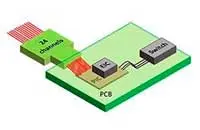Electronics News
Archive : 21 November 2016 год
 A research team from King Abdullah University of Science and Technology has developed a microsupercapacitor with three-dimensional porous electrodes. These microscale power units could enable a new generation of ‘smart’ products, such as self-powered sensors for wearables, security, structural health monitoring and IoT applications
A research team from King Abdullah University of Science and Technology has developed a microsupercapacitor with three-dimensional porous electrodes. These microscale power units could enable a new generation of ‘smart’ products, such as self-powered sensors for wearables, security, structural health monitoring and IoT applications
“While batteries must be charged at a constant voltage, a supercapacitor charges most efficiently by drawing the maximum current that the source can supply, irrespective of voltage,” said Professor Husam Alshareef.
The team has developed integrated microsupercapacitors with vertically-scaled three-dimensional porous current collectors made from nickel foams which increase the surface area.
“This three-dimensional porous architecture allows excellent electrolyte permeability, good conductivity and faster ion transportation with maximum mass-loading of active material, which increase energy and power density in a given area,” Prof Alshareef added.
The microsupercapacitors were also asymmetric, using two different electrode materials for the cathode (nickel cobalt sulphide) and anode (carbon nanofibre), which nearly doubled the operating voltage. As a result, while delivering high power density (4mW/cm2), the microsupercapacitors had an energy density of 200µWh/cm2.
This is said to be superior to other microsupercapacitors, which achieve between one and 40µWh/cm2. These capacities were maintained even after 10,000 operating cycles.
According to the researchers, supercapacitors could function for self-powered system applications where the power source may be intermittent.
Author
Peggy Lee
Source: www.newelectronics.co.uk
 French research institute Leti has announced the launch of an EC funded project designed to enable the mass commercialisation of silicon photonics based transceivers for use in data centres and by supercomputing systems.
French research institute Leti has announced the launch of an EC funded project designed to enable the mass commercialisation of silicon photonics based transceivers for use in data centres and by supercomputing systems.
The project, called COSMICC, will combine CMOS electronics and silicon photonics with high throughput fibre attachment techniques. The collaborators says the scalable solutions it develops should provide an order of magnitude better performance than today’s VCSELs. It adds the project aims to achieve a cost per bit target that cannot be met using traditional wavelength-division multiplexing transceivers.
The project’s 11 partners from five countries are focusing on developing mid-board optical transceivers with data rates up to 2.4Tbit/s, allowing up to 200Gbit/s when using 12 fibres. These devices will consume less than 2pJ/bit, the partners claim, and cost approximately €0.2/Gbit/s.
“By enhancing an R&D photonic integration platform from STMicroelectronics, the partners in COSMICC aim to demonstrate the transceivers by 2019,” said project leader Ségolène Olivier, from Leti. “We also plan to establish a new value chain that will facilitate rapid adoption of the technologies developed by our members.”
According to the partners, several developments will be used to boost the photonic integration platform’s performance, whilst reducing power consumption.
One such improvement will be to introduce a SiN layer, enabling temperature insensitive MUX/DEMUX devices to be developed for coarse WDM operation. In addition, the SiN layer will serve as an intermediate wave-guiding layer for optical I/O to and from the photonic chip.
In addition to Leti, the partners include STMicroelectronics, University of Pavia, Finisar, Ayming, Vario-Optics, Seagate, University Paris-Sud, University of St Andrews and the University of Southampton.
Author
Graham Pitcher
Source: www.newelectronics.co.uk
 A technology developed at Stanford that hitchhikes on radio signals could provide a way to control IoT devices.
A technology developed at Stanford that hitchhikes on radio signals could provide a way to control IoT devices.
“HitchHike is the first self-sufficient WiFi system that enables data transmission using just micro-watts of energy – almost zero,” researcher Pengyu Zhang said. “It can be used as it is with existing WiFi without modification or additional equipment. You can use it right now with a cell phone and your off-the-shelf WiFi router.”
According to the team, HitchHike is so low power that a small battery could drive it for a decade or more. It even has the potential to harvest energy from existing radio waves and use that electromagnetic energy, plucked from its surroundings, to power itself – perhaps indefinitely.
“HitchHike could lead to widespread adoption in the Internet of Things,” explained associate professor Sachin Katti. “Sensors could be deployed anywhere we can put a coin battery that has existing WiFi. The technology could potentially even operate without batteries. That would be a big development in this field.”
The Hitchhike prototype is a processor and a radio. With a range of up to 50m and able to transmit up to 300kbits/s, it supposedly measures the size of a postage stamp, but the engineers believe that they can make it smaller for use in implanted bio-devices like a wireless heart rate sensor.
HitchHike translates incoming radio waves from a smartphone or a laptop to its own message and retransmits its own data on a different WiFi channel to avoid radio interference between the original signal and its new data stream.
On the processor front, HitchHike is a simple translation device. HitchHike translates the incoming code words into its own data. If the incoming code word indicates a zero and HitchHike wants it to remain a zero, it passes that code word unaltered. If, however, HitchHike wants to change that zero to a one, or vice versa, it translates it to the alternate code word.
The researchers say HitchHike could be available to be incorporated into wireless devices in the next three to five years.
Author
Peggy Lee
Source: www.newelectronics.co.uk
Scientists at the University at Buffalo have identified a fluorescent dye called BODIPY as a suitable material for stocking energy in rechargeable, liquid-based batteries that could one day power small and large scale devices, including cars and homes.
According to the researchers, a BODIPY-based test battery can operate efficiently and with longevity, running well after researchers drained and recharged it 100 times.
"All alternative energy sources are intermittent, so we need batteries that can store enough energy to power the average house," explained lead researcher Timothy Cook.
Redox flow batteries consist of two tanks of fluids separated by various barriers.
When the battery is being used, electrons are harvested from one tank and moved to the other, generating an electric current. To recharge the battery, solar, wind or other energy sources would be used to force the electrons back into the original tank.
Redox flow batteries can be enlarged to store more energy – enough to allow a homeowner to power a solar house overnight, for instance, or to enable a utility company to stockpile wind energy for peak usage times.
Also, according to Cook, lithium-ion batteries are risky in that they can catch fire if they break open. If the dye-based batteries ruptured, however, they would simply leak.
"The library of molecules used in redox flow batteries is currently small but is expected to grow significantly in coming years," Cook says. "Our research identifies BODIPY dye as a promising candidate."
The BODIPY compounds display a notable quality: they can give up and receive an electron without degrading. This trait enabled the dye to store electrons and facilitate their transfer between the battery's two ends during repeated cycles of charging and draining.
Based on the experiments, scientists predicted BODIPY batteries could generate 2.3V of electricity.
Author
Peggy Lee
Source: www.newelectronics.co.uk
